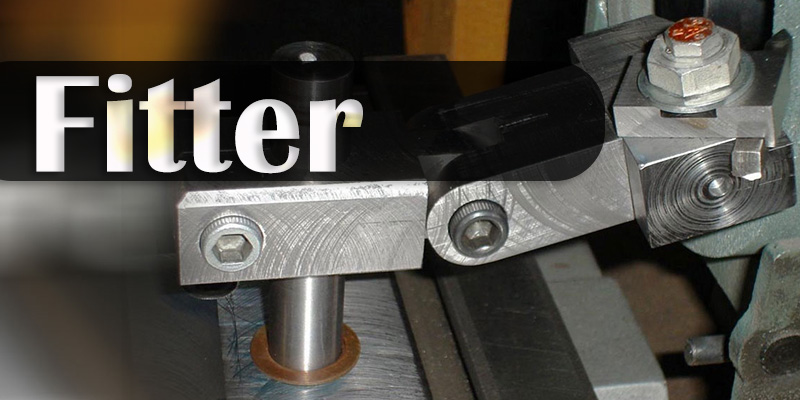
The syllabus for the ITI Trade "Fitter" in English. This two-year course, offered under the Craftsman Training Scheme (CTS) by the National Council for Vocational Training (NCVT), trains students in assembling, fitting, and maintaining mechanical components and machinery, preparing them for roles such as Fitter, Machine Assembler, or Maintenance Technician. The syllabus includes Trade Theory, Trade Practical, Workshop Calculation and Science, Engineering Drawing, and Employability Skills. Here’s the detailed breakdown:
1. Trade Theory
This section provides theoretical knowledge about fitting, tools, and mechanical systems.
Year 1
- Introduction to Fitter Trade
- Scope and importance of the fitter trade in industries.
- Role of a fitter in assembly, repair, and maintenance.
- Basic Workshop Practices
- Types of hand tools: hammers, chisels, files, hacksaws—uses and care.
- Measuring tools: vernier calipers, micrometers, gauges—accuracy and applications.
- Marking tools: punches, scribers, dividers.
- Materials and Properties
- Ferrous metals: iron, steel—properties and uses.
- Non-ferrous metals: copper, aluminum, brass—applications.
- Heat treatment: annealing, hardening, tempering.
- Fitting Techniques
- Filing, sawing, drilling, tapping, and reaming processes.
- Types of fits: clearance, interference, transition.
- Fasteners: bolts, nuts, screws, rivets—selection and use.
- Safety Practices
- Workshop safety: use of personal protective equipment (PPE) like goggles, gloves.
- Fire safety and first aid procedures.
- Safe handling of tools and machines.
- Basic Machines
- Lathe, drilling, and grinding machines: parts and functions.
- Introduction to power transmission: belts, gears, chains.
Year 2
- Advanced Fitting
- Precision fitting: scraping, lapping, and surface finishing.
- Assembly of mechanical components: bearings, shafts, couplings.
- Machine Maintenance
- Preventive and breakdown maintenance of machinery.
- Lubrication systems: types and importance.
- Fault diagnosis and repair techniques.
- Pneumatic and Hydraulic Systems
- Basics of pneumatics: air compressors, valves, cylinders.
- Hydraulics: pumps, actuators, fluid properties.
- Welding and Joining
- Introduction to arc welding and gas welding.
- Soldering and brazing techniques.
- Quality Control
- Inspection methods: visual, dimensional, and functional checks.
- Use of gauges and comparators for quality assurance.
- Industrial Applications
- Role of fitters in manufacturing, automotive, and construction industries.
- Reading and interpreting assembly drawings.
2. Trade Practical
This hands-on component develops practical skills in fitting and maintenance.
Year 1
- Basic Fitting Skills
- File flat surfaces and check flatness with try squares.
- Cut metal with hacksaws and chisels to specified dimensions.
- Drill holes, tap threads, and ream for smooth finishes.
- Measurement and Marking
- Use vernier calipers, micrometers, and height gauges for precision measurement.
- Mark lines, angles, and curves using scribers and dividers.
- Assembly Practice
- Assemble simple components using bolts, nuts, and keys.
- Fit bearings and bushes into housings.
- Safety Drills
- Use PPE during all practical tasks.
- Practice first aid for minor cuts and burns.
Year 2
- Advanced Fitting
- Perform scraping and lapping for precision fits.
- Assemble and dismantle complex assemblies (e.g., gearboxes, pumps).
- Machine Operation
- Operate lathes for facing, turning, and threading.
- Use grinding machines for sharpening tools and finishing surfaces.
- Maintenance Tasks
- Lubricate machine parts and replace worn components.
- Repair simple mechanical faults in machinery.
- Welding Practice
- Perform basic arc and gas welding joints.
- Solder and braze small components.
- Project Work
- Fabricate and assemble a functional mechanical item (e.g., vice, tool box).
- Overhaul a small machine or engine under supervision.
3. Workshop Calculation and Science
This covers mathematical and scientific principles relevant to fitting.
- Calculations
- Area, volume, and weight calculations for materials.
- Tolerance and clearance computations for fits.
- Science
- Properties of metals: hardness, ductility, elasticity.
- Friction, force, and pressure in mechanical systems.
4. Engineering Drawing
This focuses on technical drawing skills for fitting tasks.
- Drawing Basics
- Sketch orthographic and isometric views of components.
- Use symbols for threads, welds, and tolerances.
- Assembly Drawings
- Draw detailed diagrams of mechanical assemblies (e.g., pumps, vices).
- Interpret blueprints for fitting jobs.
5. Employability Skills
This enhances professional skills for job readiness.
- Communication
- Interact with supervisors and team members effectively.
- Workplace Skills
- Time management, teamwork, and problem-solving.
Course Overview
- Duration: 2 years (4 semesters of 6 months each)
- Eligibility: Passed 10th class examination under the 10+2 system with Science and Mathematics or equivalent.
- Objective: To train individuals in fitting, assembling, and maintaining mechanical systems, preparing them for careers in manufacturing, automotive, construction, or maintenance sectors.
This syllabus aligns with the NCVT framework for the "Fitter" trade and may vary slightly by state or ITI. For the latest official version, refer to the Directorate General of Training (DGT) website or local ITI resources.
Trade Type
- 141 views